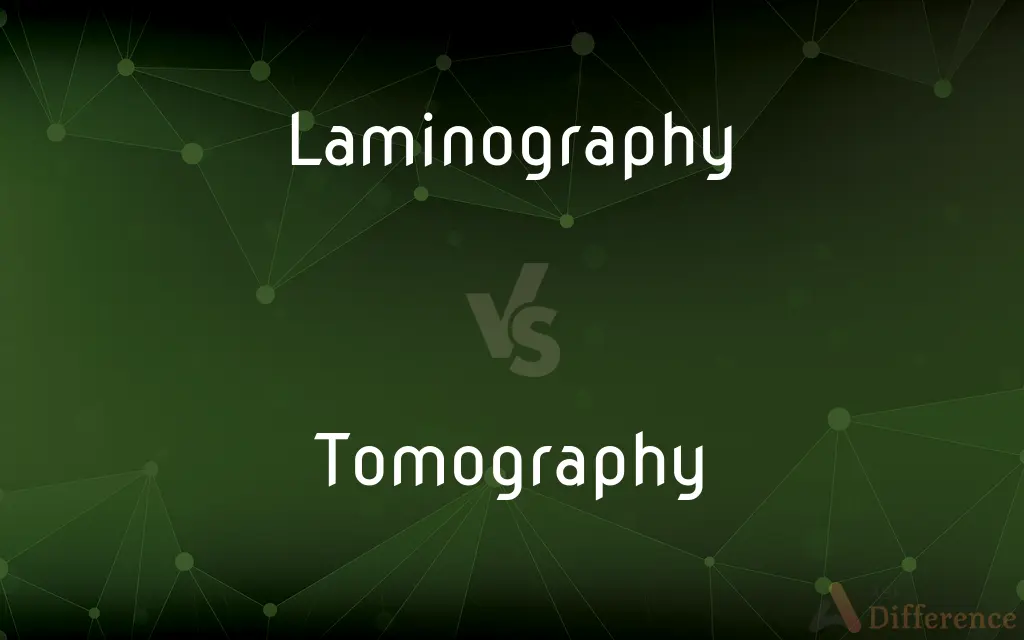Laminography vs. Tomography — What's the Difference?
By Maham Liaqat & Urooj Arif — Updated on March 29, 2024
Laminography focuses on imaging a single plane of a thick object, ideal for examining layered materials, whereas tomography visualizes sections through 3D objects, often used in medical imaging.

Difference Between Laminography and Tomography
Table of Contents
ADVERTISEMENT
Key Differences
Laminography is a technique used to image a specific layer or plane within a thick object, minimizing the visibility of other layers. This method is particularly useful for inspecting layered materials in industries such as electronics and materials science. On the other hand, tomography involves the imaging of sections through a three-dimensional object, providing detailed cross-sectional views. This approach is widely utilized in medical imaging to diagnose and monitor various health conditions.
While laminography is specialized for examining objects where a single layer’s detail is crucial, often for identifying faults or features within that layer, tomography offers a broader view, allowing for the examination of structures within the entire volume of an object. This difference makes tomography more versatile for applications that require an understanding of an object's internal configuration across multiple planes.
In laminography, the imaging technique involves moving the source and detector in a synchronized pattern to focus on a specific plane, thus blurring out details in other planes. This selective focus is beneficial for inspecting complex components, like printed circuit boards. Conversely, in tomography, both the source and detector rotate around the object, capturing multiple images from different angles to reconstruct a 3D model, enabling detailed analysis of the internal structure.
Laminography's main advantage lies in its ability to inspect specific layers of complex, multilayered objects without disassembly. This is particularly valuable in quality control processes. Whereas, tomography's strength lies in its comprehensive imaging capability, making it indispensable in fields such as medicine for diagnosing diseases, planning treatments, and monitoring therapy progress.
Despite their differences, both laminography and tomography share the underlying principle of non-destructive testing and imaging, allowing for the detailed examination of internal structures without damaging the object. Each technique, however, is optimized for different applications based on the depth and type of detail required.
ADVERTISEMENT
Comparison Chart
Focus
Specific layer or plane
Cross-sectional views of a 3D object
Main Use
Layered materials inspection
Medical imaging, geological surveys
Imaging Technique
Synchronized movement of source and detector
Rotation of source and detector around the object
Applications
Electronics, materials science
Medicine, dentistry, geology
Advantages
Inspects specific layers without disassembly
Provides comprehensive 3D views for diagnosis and study
Compare with Definitions
Laminography
Minimizes visibility of other layers for clearer inspection.
Laminography reveals hidden layers of ancient manuscripts without damage.
Tomography
Provides cross-sectional images of a 3D object.
CT scans, a form of tomography, are crucial for diagnosing internal injuries.
Laminography
A method to focus on a specific plane within an object.
Laminography is used to inspect solder joints on circuit boards.
Tomography
Diagnosing diseases, planning treatments, and monitoring therapy.
Oncologists rely on tomography to track the progress of cancer treatments.
Laminography
Non-destructive testing of electronic components and assemblies.
Manufacturers use laminography to check for defects in multilayer PCBs.
Tomography
Widely used in medical imaging and geological surveys.
Tomography helps in identifying tumors and monitoring their treatment.
Laminography
Ideal for examining layered structures in industrial materials.
In aerospace engineering, laminography examines composite materials for defects.
Tomography
Offers a detailed view of an object's internal structure.
Dental tomography provides detailed images for implant planning.
Laminography
Involves synchronized movement of the X-ray source and detector.
Laminography's precise movements isolate a plane for detailed examination.
Tomography
Captures images from multiple angles to reconstruct a 3D model.
PET scans use tomography to visualize metabolic processes in the body.
Laminography
Tomography
Tomography
Tomography is imaging by sections or sectioning that uses any kind of penetrating wave. The method is used in radiology, archaeology, biology, atmospheric science, geophysics, oceanography, plasma physics, materials science, astrophysics, quantum information, and other areas of science.
Tomography
Any of several techniques for creating three-dimensional images of the internal structure of a solid object by analyzing the propagation of waves of energy, such as x-rays or seismic waves, through the object.
Tomography
Imaging by sections or sectioning.
Tomographic imaging
Tomography
(medicine) obtaining pictures of the interior of the body
Common Curiosities
Can laminography be used in medical imaging?
While possible, laminography is less commonly used in medicine compared to tomography, which offers comprehensive 3D images.
What is laminography?
Laminography is an imaging technique focusing on a specific layer or plane within a thick object, ideal for inspecting layered materials.
How does laminography differ from tomography?
Laminography focuses on a single plane or layer, while tomography provides cross-sectional views of a 3D object.
What is tomography used for?
Tomography is widely used in medical imaging, geology, and various fields requiring detailed internal views of objects.
Can tomography visualize entire objects?
Yes, tomography can provide comprehensive views of an object's internal structure in three dimensions.
Is laminography a type of tomography?
Laminography is a specialized form of tomography focused on imaging specific layers within an object.
What are the advantages of laminography?
Laminography's main advantage is its ability to inspect specific layers of complex objects without disassembly.
Is laminography suitable for inspecting aerospace materials?
Yes, laminography is used to inspect aerospace materials, especially composite layers, for defects and quality control.
What are the main applications of laminography?
Laminography is primarily used in electronics and materials science for inspecting layered structures.
Can laminography detect defects in electronic components?
Yes, laminography is particularly effective at detecting defects in layered electronic components, such as multilayer PCBs.
How does tomography work?
Tomography involves rotating the imaging source and detector around the object, capturing multiple angles to reconstruct a 3D model.
Which is better for medical imaging, laminography or tomography?
Tomography is generally preferred for medical imaging due to its ability to provide detailed cross-sectional and 3D images.
How do the imaging techniques of laminography and tomography differ?
Laminography uses synchronized movements of the X-ray source and detector to focus on a specific plane, while tomography rotates around the object to capture multiple angles for 3D reconstruction.
Are laminography and tomography non-destructive?
Both techniques are non-destructive, allowing for the examination of internal structures without damaging the object.
What type of tomography is used in hospitals?
Hospitals commonly use CT (Computed Tomography) scans, a form of tomography, for diagnostic purposes.
Share Your Discovery

Previous Comparison
Terribly vs. Awfully
Next Comparison
Downgrade vs. DegradeAuthor Spotlight
Written by
Maham LiaqatCo-written by
Urooj ArifUrooj is a skilled content writer at Ask Difference, known for her exceptional ability to simplify complex topics into engaging and informative content. With a passion for research and a flair for clear, concise writing, she consistently delivers articles that resonate with our diverse audience.
















































